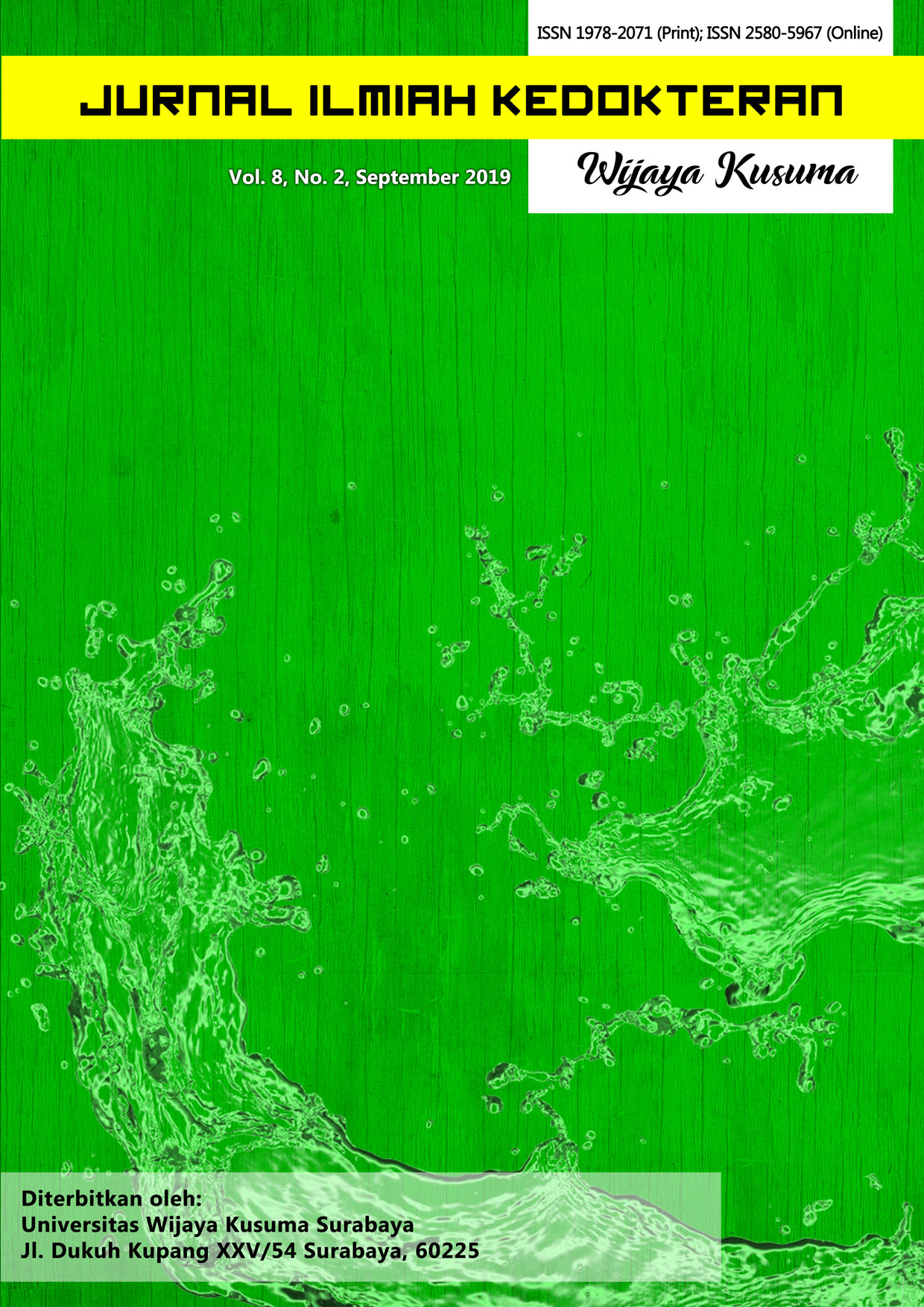Potensi Madu sebagai Terapi Topikal Otitis Eksterna
DOI:
https://doi.org/10.30742/jikw.v8i2.619Keywords:
potensi madu, terapi topikal, otitis eksternaAbstract
Otitis externa (OE) is an external microbial Meatus acousticus (MAE) infection due to damage to the normal MAE serumen skin coat that protects and maintains MAE moisture and temperature. Living in the warm and humid tropics, a decrease in skin pH due to activity in the water including swimming, and excess cerumen cleaning are predisposing factors for OE. The use of antibiotics locally concentrated in OE can not only attack pathogenic microbes but also have an impact on normal flora so that it has the potential to cause resistant microbes. Honey has anti-bacterial properties without the risk of resistance and has even been shown to modulate immunity and inflammation. Various invivo and invitro studies prove that honey has broad spectrum anti-bacterial activity. Honey is proven invitro to modulate immunity by affecting the release of various inflammatory cytokines. This shows that honey has the potential for OE therapy. This article aims to discuss the potential of honey as a topical OE therapy in the hope that it can be an alternative choice of therapy in the management of OE in humans that is safe, effective, and efficient.References
Afroz R, Tanvir EM, Zheng W, Litte PJ, 2016. Molecular pharmacology of honey, Clin Exp Pharmacol 6:1-13
Aron M, Victoria AO, Dorin D, Daniel S, 2012. Otologic safety of manuka honey, J Otolaryngol Head Neck Surg 41: S21-30
Alqurashi AM, Masoud EA, Alamin MA, 2013. Antibacterial activity of saudi honey against gram negative bacteria, Journal of Microbiology and Antimicrobials 5(1): 1-5
Aryanugraha PT, Setiawan EP, 2012. Kejadian otitis eksterna pada masyarakat penebel tabanan dan yangapi bangli yang berkunjung ke bakti sosial staf medis fungsional telinga hidung tenggorokan fakultas kedokteran universitas udayana - rumah sakit umum pusat sanglah pada tahun 2012, ISM 5(1):60-63
Bobany DM, Martins RRC, 2013. Antimicrobial natural products:
apitherapy, Formatex: 940-945
Bogdanov S, 2016. Honey in medicine, Bee Product Science, www.bee-hexagon.net
Boukraa L, 2014. Honey in traditional and modern medicine. London: CRC Press, pp. 37-57
Badan Pengawas Obat dan Makanan, 2015. Penyalahgunaan madu, propolis, dam bee pollen, Naturakos 10(29): 5-6
Caliman JDC, Riberio FAQ, Pereira GS, Alves AL, 2008. Immunohistochemistry of external auditry canal: systemic review, Int. Arch. Otolaryngol 12(2):258-73
Departemen Agama, 2010. Al-Qur’an tajwid dan terjemah. Bandung: CV Penerbit Diponegoro, pp. 267-81
Devasravaran K, Yoke-KY, 2016. Anti inflammatoryand wound healing properties of malaysia tualang honey, Current Science 110(1): 47-51
Gul W, Farooq N, Khan U, Rehan F, Anees D, 2015. Honey: a nectarous anti infective agent, World Journal of Phamaceutical Sciences 4(4):208-15
Hussein SZ, Yusoff KM, Makpol S, Yussof YAM, 2013. Gelam honey attenuates carrageenan-induced rat paw inflammation via nf-kb pathway, Plos One 8(8):1-12
Kolegium Ilmu Kesehatan T.H.T.K.L, 2015. Modul I.4 Inflamasi telinga luar, Edisi II, Jakarta
Kwakman PHS, Zaat SAJ, 2012. Antibacterial componen of honey, Life,64(1):48-55
Lucente FE, Linstrom CJ, 2014. Disease of the external ear. In: Johnson JT, Rosen CA, Newlands S, Amin M, Branstetter B, Casselbrant M, et al., eds. Bailey’s head and neck surgery otolaryngology, 5th edition, Vol 2, Philadelphia: Lippincott Williams & Wilkins, pp. 2333-57
Mandal MD, Mandal S, 2011. Honey: its medicinal property and antibacterial activity, Asian Pac J Trop. Biomed 1(2):154-60
Maruhashi E, Braz BS, Nunes T, Pomba C, Belas A, Henrique J, et al., 2016. Efï¬cacy of medical grade honey in the management of canine otitis externa-a pilot study, Vet Dermatol 10:1-8
Mohamed M, Sirajudeen KNS, Swamy M, Yacoob NS, Sulaiman SA, 2010. Studies on the antioxidant properties of tualang honey of malaysia, Afr. J. Trad. CAM 7(1):59-63
Nayik GA, Shah TR, Muzaffar K, Wani SA, Gull A, Majid I, et al., 2014. Honey: its history and religious significance: a review, UJP 3(1):5-8
Noori AW, Salom K, Ahmad AA, 2011. Honey for wound healing, ulcers, and burns; data suporting its use in clinical practice, The Scientific World Journal 11:766-87
Othman Z, Zakaria R, Hussein NHN, Hassan A, Shafin N, Badriya AR, et al., 2015. Potential role of honey in learning and memory, Med Sci 3:3-15
Pyrzynska K, Biesaga M, 2009. Analysis of phenolic acids and flavanoids in honey, Trends in Analitical Chemistry 28:893-902
Robert AEL, Brown HL, Jenkins RE, 2015. On the antibacterial effects of manuka honey: mechanistic insights, Research and Reports in Biology 6:215–24
Rosenfeld RM, Schwartz SR, Cannon CR, Roland PS, Simon GR, Kumar KA, et al., 2014. Clinical practice guideline: acute otitis externa, Otolaryngology-Head and Neck Surgery150(1S): S1 –S24
Sooryadas S, Deepthy BJ, 2013. Treatment of pseudomonas infected chronic otitis externa in dogs using indian “khadikraft†honey as ear drops, IJAVMS 7:12-4
Suarez JMA, Gasparrini M, Hernandez TYF, Mazzoni L, Giamperi F, 2014. The composition and biological acivity of honey: a focus on manuka honey, Foods 3:420-32
Suwu P, Kountul C, Waworuntu O, 2013. Pola kuman dan uji kepekaannya terhadap antibiotika pada penderita otitis eksterna di poliklinik tht-kl blu rsu prof. dr. r. d. kandau manado, Jurnal e-CliniC 1(1): 20-5
Werner A, Laccourreye O, 2011. Honey in otorhinolaryngology: when, why and how?, European Annals of Otorhinolaryngology, Head and Neck disease 128:133-7
Downloads
Published
Issue
Section
License
The journal operates an Open Access policy under a Creative Commons Attribution-NonCommercial 4.0 International License. Author continues to retain the copyright if the article is published in this journal. The publisher will only need publishing rights. (CC-BY-NC 4.0)

